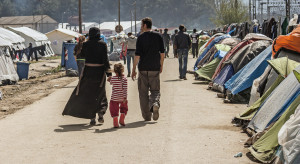The limits to economic growth due to the limited availability of resources should be undisputed. Nevertheless, there is still no final social consensus on this. Rather, constant, even exponential economic growth is a political-economic doctrine. The thermodynamics of non-linear processes with the second law and Boltzmann entropy as a directional indicator as well as synergetics contribute to the formation of opinion from a scientific perspective. Is growth as the credo of human evolution a one-way street?
Everything grows: plants, animals, humans, possibly also their motivation to achieve something specific, populations grow, even the economy, if there are no crises, streams of refugees as a result of wars and social injustice, even the universe grows. Growth is associated with terms such as enlargement, expansion, multiplication or spread; overall, one could speak of expansion. But growth is also associated with the opposite, such as accumulation, densification, the development of non-equilibrium, an increase in complexity, order out of chaos. This ambiguity surrounding the term "growth" shows that quantitative and qualitative growth factors are closely linked. In systems, subsystems, system elements and their interactions, system boundaries and interactions of systems with their environment play an important role when it comes to questions of growth.
It should be logical that there cannot be unlimited, quantitative growth within system boundaries, as system disturbances would be unavoidable if growth boundaries were exceeded. Nature shows us this in many ways. Plants, animals, humans and populations grow within limits. Logistic mathematical growth model curves, e.g. for population growth, are characterized by increases dX/dt, which fall to zero after reaching a maximum and thus ultimately lead to the end of growth. Accordingly, the growth variable X runs through a so-called S-curve from a small initial value X(a) to a larger final value X(e), which represents the asymptotic final value, i.e. the growth limit [1]. Although logistic growth curves are only a special case in growth theory [2], they illustrate the limitations of quantitative growth. Biological systems regulate themselves largely self-organized and also largely free of disturbances if the necessary high-quality energy is supplied or generated through transformation, the entropy arising in the system (see below) can be dissipated to the outside and no critical disturbance factors become effective. Other highly complex systems, including social systems, also grow and structure themselves in a largely self-organized manner, but cybernetic readjustments must be made in order not to exceed growth limits and to avoid system destabilization. Zero growth would therefore be the normal end state (steady state) in a stable complex system.
Economic growth - from a scientific perspective
 Is waste export entropy export?It should be considered a "truism" that permanent, unrestricted economic growth cannot function from the perspective of resource limitation. Innovations through science and technology can shift the limits to growth, but not remove them. Qualitative growth also has its limits, as instabilities increase with the growing complexity of systems and the resulting systemic threats can be quite real. A current example of this is the increasing number of hacker attacks in the context of accelerated digitalization, which are unfortunately too often successful. In this context, the blackout in the electricity supply should also be mentioned in particular, although it is obviously no longer a question of whether it will occur, but only when and to what extent damage is to be expected. Nevertheless, in highly developed, capitalist countries, including Germany, business, politics and the media suggest that long-term economic growth is a prerequisite for ensuring competitiveness, and therefore jobs and overall national prosperity. The question arises as to whether this is really about national prosperity for all, or rather about maximizing profits at all costs for a rich minority, as a quasi-essential feature of the capitalist mode of production. The growing gap between rich and poor despite economic growth clearly speaks in favor of the latter. As early as 2015, it was described that 1% of the world's population has accumulated more wealth than the remaining 99%. The trend is certainly not falling.
Is waste export entropy export?It should be considered a "truism" that permanent, unrestricted economic growth cannot function from the perspective of resource limitation. Innovations through science and technology can shift the limits to growth, but not remove them. Qualitative growth also has its limits, as instabilities increase with the growing complexity of systems and the resulting systemic threats can be quite real. A current example of this is the increasing number of hacker attacks in the context of accelerated digitalization, which are unfortunately too often successful. In this context, the blackout in the electricity supply should also be mentioned in particular, although it is obviously no longer a question of whether it will occur, but only when and to what extent damage is to be expected. Nevertheless, in highly developed, capitalist countries, including Germany, business, politics and the media suggest that long-term economic growth is a prerequisite for ensuring competitiveness, and therefore jobs and overall national prosperity. The question arises as to whether this is really about national prosperity for all, or rather about maximizing profits at all costs for a rich minority, as a quasi-essential feature of the capitalist mode of production. The growing gap between rich and poor despite economic growth clearly speaks in favor of the latter. As early as 2015, it was described that 1% of the world's population has accumulated more wealth than the remaining 99%. The trend is certainly not falling.
For non-economists, however, it is difficult to draw the right conclusions for counterarguments from the constant, almost missionary proclamation of the possibility and necessity of sustainable economic growth and such controversial publications as "Prosperity without growth" [3]. But what if we look at the problem of growth through the eyes of a scientist and focus on the social gradient as a factor that inhibits growth? The social gradient describes the degree of inequality in the distribution of socially generated wealth and is therefore a measure of social inequality. This means that people either have significantly more or less of certain resources (e.g. level of education, income) and living conditions (e.g. housing conditions, security, health) and can therefore only realize their potential within certain limits. This article is by no means about mixing different scientific fields, nor is it about a new theory of growth, but merely about additional, compelling arguments for the fact that there are objective limits to growth that should not be ignored. It seems promising to use the thermodynamics of non-linear processes and synergetics to approach such socio-economic considerations without ideology [1, 2, 4 to 8]. Synergetics is the science of interaction in highly complex systems, or more precisely of the ordered, self-organized, collective, but also competing behaviour of individuals (atoms, molecules, cells, animals, humans) in complex systems.
To understand: Open systems can enable structural development (formation and maintenance of order) through dissipative self-organization. These are processes that take place in competition between non-linearity with structural reinforcement (increasing the degree of order) on the one hand and the influence of dissipation (structural dissolution, dispersion) on the other, but without targeted control from outside. This requires a number of prerequisites: supercritical distance from thermodynamic equilibrium, supply of high-value energy, energy transformation in the system to generate usable energy, release of low-value energy (low-temperature heat) and entropy to the environment. Entropy is a thermodynamic state variable and, according to Boltzmann, is a measure of the worthlessness of energy and therefore the degree of disorder in a system. According to the second law of thermodynamics, self-organization can occur in a system if the entropy export from the system is greater than the amount of entropy generated in the system in given time intervals. The operationally closed nature of an inherently open, complex system means that feedback between the macrostructure of the system and the microbehavior of the system components is possible [1]. Positive feedback reinforces the system dynamics, while negative feedback has a dampening effect.
A textbook example of self-organized interactions in complex systems is the laser. The energy absorbed by the atoms and molecules of the laser medium is re-emitted as light of the same wavelength and amplified by positive feedback. As a result of competing interactions, one wavelength acts as a folder and forces all other wavelengths into synchronization (synchronization, also known here as "enslavement"). Microscopic chaos has become macroscopic order through dissipative self-organization, a synchronized wave, the laser. Folders and enslavement are mutually dependent, with a few folders ensuring the orderly behavior of many system elements [5]. It is interesting to note that the results of well-studied physical-chemical and biological systems in this respect can essentially also be transferred to highly complex, dynamic, social systems. For example, it can be assumed that profit maximization as a basic capitalist principle is based not only on the sum of individual activities, but in particular also on the self-organizing, collective, but also competing behaviour of the individuals in the system, i.e. on an internal system constraint. Or the fact that the prevailing public opinion in a society does not arise from the sum of individual opinions, but as a result of interactions and synchronization between individuals, politics and the media.
Social gradient - growth-promoting, but also growth-inhibiting
If we follow the theory of dissipative self-organization in the following observations on growth, the necessary distance from equilibrium can be determined, among other things, by the social gradient. Although it seems rather unlikely at first glance, the unequal distribution of socially generated wealth supports structural development within certain limits and can therefore also be regarded as an internal driving force for economic growth. Distributive injustice that inhibits economic growth only begins when the unequal distribution destabilizes the social order. In such a situation, even the slightest disruption can call the existing social order into question due to the non-linearity of the processes, resulting in phase transitions that lead either to a different order (e.g. democracy to dictatorship) or to turbulent chaos. In this context, the butterfly effect in chaos theory comes to mind, for example. Complex systems that are far from equilibrium can even oscillate between order and chaos. This is also conceivable for social systems.
A destabilization of the system as a result of stark social differences can be seen in the accumulation of extreme events, such as escalating demonstrations, escalating strikes, disproportionately high flows of refugees, an increase in crime and terrorist attacks as well as the intensification of armed conflicts. Politicians will then hardly be able, or even willing, to successfully perform their role as stewards for the stabilization of the existing system. With this in mind, it is advisable to analyze the current national and international situation, e.g. the refugee crisis, critically and without ideology in order to quickly implement globally effective measures to reduce social injustice.
Butterfly effect
 When processes are non-linear, the slightest disturbance can call social order into question, writes Fischwasser, recalling the butterfly effect in chaos theory, according to which "the smallest changes in the initial conditions of the system have a long-term effect on the development of the system".
When processes are non-linear, the slightest disturbance can call social order into question, writes Fischwasser, recalling the butterfly effect in chaos theory, according to which "the smallest changes in the initial conditions of the system have a long-term effect on the development of the system".
An interim conclusion could therefore be that the beginning of such a phase of social destabilization correlates with a critical social gradient, which also has an inhibiting effect on economic growth. Forced further economic growth is then exclusively profit-oriented and in no way serves the general welfare of the people. Worse still, an exacerbation of social injustice with system-destroying effects is even condoned.
However, it is not only changes to the status quo that are systemically relevant, but also the dynamics of change in particular, in this case the dynamics of growth. A high growth dynamic makes it more difficult for individuals to adapt to new situations in increasingly complex social systems and is very likely to make this impossible from a certain point onwards, meaning that system-destroying effects can also be expected from this perspective. The accelerated digitalization of all social processes should serve as an example. There are many indications that digitalization as a qualitative growth factor will primarily serve to further maximize profits and only partially serve the common good. This will inevitably lead to a further tightening of the social gradient. After all, in an extremely "money-oriented" social order, everything has to be profitable, so digitalization will most likely result in far more jobs disappearing than new ones being created. Only time will tell.
It is also worth noting information from the scientific community that with the growing dynamics of digital structure-building processes, "artificial intelligence" could at some point take on a life of its own and even withdraw from human influence [9]. A horror scenario in the discussion about growth and growth limits.
What to do with entropy?
 Currently, wars...Economic growth is linked to increasing energy requirements. If the energy flow suddenly stops, a complexly structured social order collapses and with it economic growth. The current energy crisis is a vivid illustration of this. The form of energy required for human activity, e.g. electrical energy, must be generated by transforming the input forms of energy (solar, wind, nuclear and chemical energy from fossil fuels). The current difficulties in converting energy sources to sustainability in connection with overcoming the climate crisis are already clearly pointing to the braking effects on economic growth. The reasons for this are the emerging supply insecurity in the provision of energy, but also the exacerbation of the social gradient as a result of profit-oriented, unfair distribution of the costs incurred. It should not go unmentioned at this point that energy transformations obviously influence economic growth right down to the mental sphere of the individual and are therefore systemically relevant.
Currently, wars...Economic growth is linked to increasing energy requirements. If the energy flow suddenly stops, a complexly structured social order collapses and with it economic growth. The current energy crisis is a vivid illustration of this. The form of energy required for human activity, e.g. electrical energy, must be generated by transforming the input forms of energy (solar, wind, nuclear and chemical energy from fossil fuels). The current difficulties in converting energy sources to sustainability in connection with overcoming the climate crisis are already clearly pointing to the braking effects on economic growth. The reasons for this are the emerging supply insecurity in the provision of energy, but also the exacerbation of the social gradient as a result of profit-oriented, unfair distribution of the costs incurred. It should not go unmentioned at this point that energy transformations obviously influence economic growth right down to the mental sphere of the individual and are therefore systemically relevant.
Increasing energy turnover through human activities also produces an increasing amount of entropy (waste heat, waste), which must be removed from the system. Disorder must be released into the environment if order and structure are to be maintained in the system. The more complex and multi-layered a social system is, the higher the energy requirement and the necessary entropy export. It is therefore interesting to note that entropy export is like "sweeping garbage outside the door" [8]. This comparison can be taken literally and entropy export can be reduced to waste heat and waste streams, which are increasingly flowing on a large scale from structurally strong to structurally weak countries, thus increasingly polluting the environment globally and, in particular, contributing to climate deterioration. However, this would be too short-sighted when considering economic growth and its limits. Disorder is also released into the environment in a figurative sense when highly developed, capitalist industrialized countries (systems) base their economic growth largely on the exploitation of developing countries (environment). The use of cheap raw materials and energy sources, as well as cheap labour, while at the same time preventing the developing countries from developing their own structures, characterizes this exploitation and thus, from a different perspective, also the entropy transfer. The focus is not on helping people to help themselves, but on the selfish use of resources and favourable sales markets in order to maximize profits, i.e. order and economic growth at the expense of third parties.
 ... but also refugee flows, in this case the Idomeni refugee camp in Greece, to destabilize the system Rifkin [10] has summed up this development from the point of view of thermodynamics: "Evolution creates islands of order in ever larger seas of disorder". The author links social evolution with increasing waste of energy, unchecked exploitation of the environment and oppression of peoples. Supercritical energy flow for structural development in highly developed countries causes supercritical entropy export. This in turn exacerbates the global social gradient. There is therefore a correlation between entropy export, social gradient and limits to economic growth. The example of exorbitant refugee flows from structurally weak, poor countries to structurally strong, rich countries illustrates the destabilizing effects of extreme social gradients in the long term. A refugee crisis has emerged, and it is becoming increasingly clear that the effort required to cope with it is also severely slowing economic growth in rich countries. If, for example, the refugee crisis cannot be resolved as quickly as possible through effective help for self-help on the ground, structural development will no longer be possible in the foreseeable future, even for the "islands of order". Similar considerations are also necessary in the context of the climate crisis.
... but also refugee flows, in this case the Idomeni refugee camp in Greece, to destabilize the system Rifkin [10] has summed up this development from the point of view of thermodynamics: "Evolution creates islands of order in ever larger seas of disorder". The author links social evolution with increasing waste of energy, unchecked exploitation of the environment and oppression of peoples. Supercritical energy flow for structural development in highly developed countries causes supercritical entropy export. This in turn exacerbates the global social gradient. There is therefore a correlation between entropy export, social gradient and limits to economic growth. The example of exorbitant refugee flows from structurally weak, poor countries to structurally strong, rich countries illustrates the destabilizing effects of extreme social gradients in the long term. A refugee crisis has emerged, and it is becoming increasingly clear that the effort required to cope with it is also severely slowing economic growth in rich countries. If, for example, the refugee crisis cannot be resolved as quickly as possible through effective help for self-help on the ground, structural development will no longer be possible in the foreseeable future, even for the "islands of order". Similar considerations are also necessary in the context of the climate crisis.
History offers numerous examples of how advanced civilizations geared exclusively towards growth have perished due to the extreme increase in expenditure to maintain growth. One example is the Roman Empire, which continued to expand its empire but ultimately collapsed due to a lack of energy. The increasing energy deficit made it impossible to keep the infrastructure and population in a stable non-equilibrium.
Conclusion:
 Social inequality could also upset the social orderSocial gradientsthat destabilize social systems as a result of profit maximization ultimately also limit economic growth. Supercritical entropy export and its consequences illustrate this. However, growth limits cannot be specified exactly, as it is possible to temporarily force economic growth beyond a critical limit. However, any resulting systemic destruction is then accepted by the protagonists involved. Current crisis situations, such as the refugee and climate crisis, exacerbated by the coronavirus pandemic as well as armed conflicts and the looming difficulties in overcoming them, underline this.
Social inequality could also upset the social orderSocial gradientsthat destabilize social systems as a result of profit maximization ultimately also limit economic growth. Supercritical entropy export and its consequences illustrate this. However, growth limits cannot be specified exactly, as it is possible to temporarily force economic growth beyond a critical limit. However, any resulting systemic destruction is then accepted by the protagonists involved. Current crisis situations, such as the refugee and climate crisis, exacerbated by the coronavirus pandemic as well as armed conflicts and the looming difficulties in overcoming them, underline this.
Looking to the future, however, the question also arises: is a "sea of order without islands of disorder" conceivable? No, if greed for profit and increasing social injustice continue to determine social processes. Yes, if globally cooperative collaboration for the development of sustainable system structures could prevail, if growth limits were recognized and taken into account not only in economic development but also with regard to population growth, and if all public resources were used in an ecologically and socially compatible manner.
It is a "must" to drastically reduce entropy production, so that in many areas even questions of redistribution of material goods, but also renunciation instead of greed for profit, should be part of the social consensus. In this context, the book "Energy, Entropy, Creativity" [11] points the way forward. It builds a bridge from the relevant scientific foundations to the driving and braking mechanisms of economic growth and the realization that the current model of prosperity also needs to be revised.
Unfortunately, the current form of capitalism does not yet offer any starting points for solving this complex problem and, in my view, offers little hope for the future.
Thanks are due to Dr. rer. nat, K.-F. Albrecht, former lecturer in Environmental Systems Analysis at the TU Dresden.
Literature
[1] W. Nachtigall: Bionik - Grundlagen und Beispiele für Ingenieure und Naturwissenschaftler, Springer-Verlag, 2nd edition (2002)
[2] K.-F. Albrecht: Environmental system analysis with the aid of computer simulation and environmental problems as evolutionary pressure for ecological and economic systems, lecture series; https://nbn-resolving.org/urn:nbn:de:bsz:14-qucosa2-78331
[3] M. Miegel: Exit - Prosperity without Growth, List Taschenbuch (2011)
[4] J. M. Rubi: How order emerges from chaos, Spektrum der Wissenschaft, 4 (2009), 30-35
[5] H. Haken: Erfolgsgeheimnisse der Natur, Synergetik: Die Lehre vom Zusammenwirken, 2nd edition, Deutsche Verlags-Anstalt Stuttgart (1981)
[6] G. Nicoles; J. Prigogine: Die Erforschung des Komplexen, R. Piper GmbH & Co. KG Munich (1987)
[7] W. Ebeling; R. Feistel: Chaos and Cosmos, Principles of Evolution, Spektrum Akademischer Verlag Heidelberg Berlin Oxford (1994)
[8] W. Ebeling: Physical Principles of the Self-Organization of Matter, Urania, Leipzig, 59 (1983) 6, 32-37
[9] S. Hawking: Short answers to big questions, Klett-Cotta (2018)
[10] J. Rifkin: Die H2-Revolution - Mit neuer Energie für eine gerechte Weltwirtschaft, Chapter 3: Aufstieg und Untergang von Kulturen nach den Hauptsätzen der Thermodynamik, Campus Verlag Frankfurt/New York (2002)
[11] R. Kümmel; D. Lindenberger; N. Paech: Energie, Entropie, Kreativität, Was das Wirtschaftswachstum treibt und bremst, Springer Spektrum (2018)


